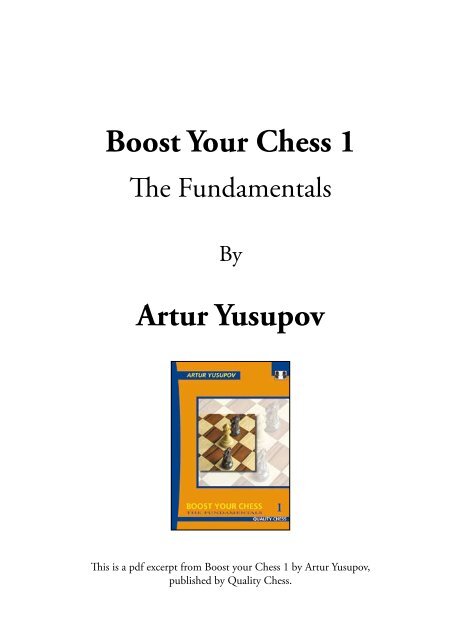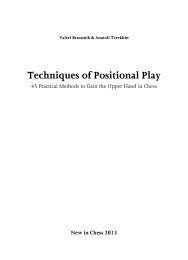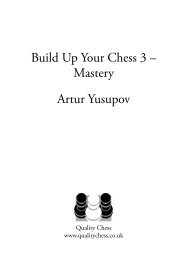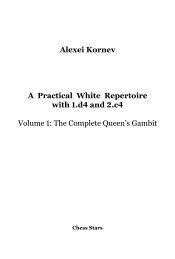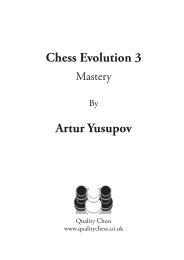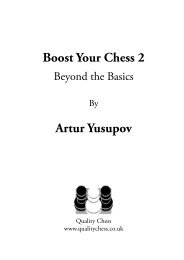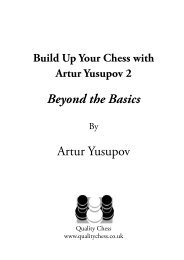Boost Your Chess 1 Artur Yusupov - London Chess Centre
Boost Your Chess 1 Artur Yusupov - London Chess Centre
Boost Your Chess 1 Artur Yusupov - London Chess Centre
You also want an ePaper? Increase the reach of your titles
YUMPU automatically turns print PDFs into web optimized ePapers that Google loves.
<strong>Boost</strong> <strong>Your</strong> <strong>Chess</strong> 1<br />
The Fundamentals<br />
By<br />
<strong>Artur</strong> <strong>Yusupov</strong><br />
This is a pdf excerpt from <strong>Boost</strong> your <strong>Chess</strong> 1 by <strong>Artur</strong> <strong>Yusupov</strong>,<br />
published by Quality <strong>Chess</strong>.
CONTENTS<br />
Key to symbols used 4<br />
Preface 5<br />
Introduction 6<br />
1 The windmill 8<br />
2 Pawn weaknesses 16<br />
3 Back rank combinations 26<br />
4 Exploiting weaknesses 34<br />
5 The 7th rank 46<br />
6 Fortresses 56<br />
7 The pawn wedge 66<br />
8 Opening traps 76<br />
9 The use of traps 86<br />
10 Stalemate combinations 96<br />
11 The semi-open file 106<br />
12 Mate with bishop and knight 118<br />
13 Combinations involving files 128<br />
14 Outposts 140<br />
15 Combinations involving diagonals 152<br />
16 Elementary endgames 160<br />
17 Combinations with knights 170<br />
18 The principles behind mobilization 180<br />
19 Perpetual check 190<br />
20 Mate in two moves 200<br />
21 Combinations with the major pieces 208<br />
22 Coordination of the pieces 218<br />
23 Combinations with knights 2 228<br />
24 Zugzwang 238<br />
Final test 246<br />
Appendices<br />
Index of composers 256<br />
Index of games 257<br />
Recommended books 265
chapter 1<br />
8<br />
Contents<br />
ü The windmill<br />
ü Coordination of the pieces<br />
ü Mating attack<br />
Diagram 1-1<br />
r<br />
1222222223<br />
Çt+ +tMl+5<br />
ÆOv+ +oO 5<br />
Å + Oo+ O5<br />
Ä+w+ + Bq5<br />
à P P + +5<br />
Â+ + N R 5<br />
Áp+ + PpP5<br />
À+ + R K 5<br />
7ÈÉÊËÌÍÎÏ9<br />
The windmill<br />
The windmill is one of the most beautiful<br />
combinations in chess. Kotov provided the definition<br />
of a windmill as ‘a forcing series of attacks with<br />
discovered check.’<br />
The following famous game made this type of<br />
combination so well-known.<br />
8<br />
Diagram 1-1<br />
C.Torre – Em.Lasker<br />
Moscow 1925<br />
The white bishop is pinned and attacked. However,<br />
White’s surprising reply turns the tables.<br />
1.¥f6!!<br />
White sacrifices his strongest piece in order to set<br />
up a windmill.<br />
1...£xh5 2.¦xg7†<br />
Now the white bishop and rook display unbelievable<br />
coordination.<br />
2...¢h8 3.¦xf7†<br />
White sets the windmill in motion. The rook first<br />
eliminates almost all of the black pieces on the seventh<br />
rank. The only way for Black to meet the discovered<br />
checks is with king moves.<br />
It would be bad to play 3.¦g5† ¢h7 4.¦xh5<br />
(White could still go back with 4.¦g7† and continue<br />
as in the game) 4...¢g6 5.¦b5 ¥c6 and Black wins a<br />
piece.<br />
3...¢g8 4.¦g7† ¢h8 5.¦xb7†<br />
It is important that the white bishop is not under<br />
attack. Otherwise it could not participate in the<br />
windmill without being in danger.<br />
5...¢g8 6.¦g7† ¢h8 7.¦g5†<br />
With another discovered check White wins back<br />
his queen. White could also have first taken the pawn<br />
on a7, but he did not want to unnecessarily open the<br />
a-file for the opposing rook.<br />
7...¢h7 8.¦xh5 ¢g6<br />
This double attack wins the piece back, but White<br />
will have a good three pawns more!<br />
9.¦h3 ¢xf6 10.¦xh6†<br />
1–0
The windmill<br />
The attacking side exploited the power of a rookbishop<br />
battery. It is very important to learn how to<br />
coordinate these different pieces. They complement<br />
each other very well. We have already seen some<br />
similar examples of this in Chapters 2 and 7 of Build<br />
Up <strong>Your</strong> <strong>Chess</strong> 1.<br />
The windmill and other similar attacking set-ups<br />
are very dangerous and often lead not ‘only’ to a gain<br />
of material, but also directly to mate.<br />
Diagram 1-2<br />
Variation from the game<br />
V.Smyslov – M.Euwe<br />
Zürich Candidates 1953<br />
1.¥xe5!<br />
A deflecting sacrifice. Another good move is<br />
1.£c5+–.<br />
1...¦xe5 2.£xe5! £xe5 3.¥xc6† ¢b8 4.¦b7† ¢a8<br />
A typical windmill, which even leads to mate in<br />
this case.<br />
5.¦b5#<br />
Diagram 1-3<br />
N.N. – W.Steinitz<br />
<strong>London</strong> 1869<br />
Here is another example which confirms how strong<br />
the rook-bishop battery is.<br />
1...£h4!!<br />
A spectacular move. The threat is 2...¦xg2† and<br />
then ...£f2†, as well as the simple 2...¦2xf3.<br />
2.¤xh4 ¥xe3!<br />
The threat is 3...¦f1#. White is left with no<br />
satisfactory defence.<br />
3.¤g6†<br />
Other moves are no better:<br />
a) 3.h3 ¦f1† 4.¢h2 ¥g1† 5.¢h1 ¤g3#.<br />
b) 3.g3 ¦e2† 4.¢h1 ¦xe1† 5.¢g2 ¦g1† 6.¢h3<br />
¤f2#.<br />
c) 3.¤f3 ¦2xf3†–+.<br />
3...hxg6 4.g3 ¦e2† 5.¢h1 ¦xe1†<br />
Black has a forced mate.<br />
Diagram 1-2<br />
<br />
r<br />
1222222223<br />
Çl+m+t+ +5<br />
ÆO +r+ Vv5<br />
Å +o+ WoO5<br />
Ä+ + Oo+ 5<br />
à +p+ + +5<br />
Â+ B Q P 5<br />
ÁpP + PbP5<br />
À+ + + K 5<br />
7ÈÉÊËÌÍÎÏ9<br />
Diagram 1-3<br />
q<br />
1222222223<br />
Ç + + T L5<br />
ÆO O W Oo5<br />
Å + + + +5<br />
Ä+ Vq+ + 5<br />
à + +m+ +5<br />
Â+ P Pn+ 5<br />
ÁpP + TpP5<br />
ÀRn+ R K 5<br />
7ÈÉÊËÌÍÎÏ9<br />
chapter 1<br />
9
chapter 1<br />
<br />
Diagram 1-4<br />
r<br />
1222222223<br />
Ç + +v+tL5<br />
Æ+ + + Wo5<br />
Å + +o+ +5<br />
Ä+oBoMoPp5<br />
à P + Q +5<br />
Â+ P +b+ 5<br />
Á + + +rK5<br />
À+ + + + 5<br />
7ÈÉÊËÌÍÎÏ9<br />
Diagram 1-5<br />
r<br />
1222222223<br />
Ç + +v+ L5<br />
Æ+ + + +o5<br />
Å + W + P5<br />
Ä+o+oRoT 5<br />
à P B + +5<br />
Â+ P +q+ 5<br />
Á + + + K5<br />
À+ + + + 5<br />
7ÈÉÊËÌÍÎÏ9<br />
Tactics 1<br />
6.¢g2 ¦g1† 7.¢h3 ¤f2† 8.¢h4 ¦f4†! 9.gxf4<br />
Or 9.¢g5 ¦g4#.<br />
9...¦g4#<br />
Diagram 1-4<br />
O.Duras – R.Spielmann<br />
Bad Pistyan 1912<br />
1.¥d4!<br />
White begins a forcing attack.<br />
1...¤xf3† 2.£xf3 e5 3.h6! £e7<br />
If 3...£c7, then 4.£f4!+–.<br />
4.¦e2<br />
4.£xd5! would be simpler: 4...exd4 5.£xd4†+–.<br />
4...¦xg5 5.¦xe5<br />
White sets up his battery. There is a strong<br />
alternative in 5.¥xe5†! ¢g8 6.¥f4+–.<br />
5...£d6<br />
Diagram 1-5<br />
The only chance. Black pins the white rook.<br />
6.£g3!!<br />
White prepares an elegant way to unpin. But not<br />
the immediate 6.¢h1 on account of 6...£xh6†–+.<br />
6...£xh6†<br />
6...¦xg3 7.¦xe8#<br />
7.£h3! £d6 8.¢h1!+–<br />
Black cannot avoid losing a piece.<br />
In the test which follows, you should try to set up<br />
a windmill! Calculate only the necessary variations.<br />
Always end your variations with an evaluation. It is<br />
important to concentrate on the first few moves and<br />
also to take into account the various possible replies<br />
by your opponent.<br />
10
Ex. 1-1 « r<br />
1222222223<br />
Ç + M + T5<br />
Æ+ O + L 5<br />
Å OvVoRoO5<br />
Ä+ + + T 5<br />
à + P + +5<br />
Â+ PbQ +p5<br />
Áw+ + +p+5<br />
À+ + +rK 5<br />
7ÈÉÊËÌÍÎÏ9<br />
Exercises<br />
1222222223<br />
Çt+ Ml+t+5<br />
ÆOv+ +w+o5<br />
Å + +o+ +5<br />
Ä+ +o+ Oq5<br />
à + + + +5<br />
ÂBp+ + + 5<br />
ÁpP + PpP5<br />
À+ R R K 5<br />
7ÈÉÊËÌÍÎÏ9<br />
Ex. 1-4 «« r<br />
<br />
chapter 1<br />
Ex. 1-2 «« r<br />
1222222223<br />
Çt+ + L T5<br />
ÆOoOr+ Oo5<br />
Å +m+ O +5<br />
Ä+ + + +b5<br />
à + +pB +5<br />
Â+ Q + + 5<br />
ÁwP + PpP5<br />
À+ K + + 5<br />
7ÈÉÊËÌÍÎÏ9<br />
Ex. 1-3 «« r<br />
1222222223<br />
Çt+ + Tl+5<br />
Æ+o+m+oOo5<br />
Åo+v+ + W5<br />
Ä+ + +p+ 5<br />
à + Bp+ +5<br />
Â+bP +q+ 5<br />
Áp+p+ + P5<br />
À+k+ + R 5<br />
7ÈÉÊËÌÍÎÏ9<br />
Ex. 1-5 « q<br />
1222222223<br />
Çt+ + +l+5<br />
ÆOo+ +oO 5<br />
Å Wo+ +o+5<br />
Ä+ +vT + 5<br />
à + + B +5<br />
Â+ +p+ +p5<br />
ÁpPp+ Qp+5<br />
ÀR + +rK 5<br />
7ÈÉÊËÌÍÎÏ9<br />
Ex. 1-6 «« r<br />
1222222223<br />
Ç +lT + +5<br />
Æ+vOt+ +o5<br />
Å + +r+ +5<br />
Ä+oQ + + 5<br />
à + + + +5<br />
Â+ + + B 5<br />
Á + W +pP5<br />
À+ R + +k5<br />
7ÈÉÊËÌÍÎÏ9<br />
11
chapter 1<br />
<br />
Ex. 1-7 «« q<br />
1222222223<br />
Çv+ + TtL5<br />
Æ+ Q M +o5<br />
Å + +o+w+5<br />
ÄO + P +r5<br />
à V B + +5<br />
Â+ + + Np5<br />
Á Pb+ PpK5<br />
À+ +r+ + 5<br />
7ÈÉÊËÌÍÎÏ9<br />
Exercises<br />
Ex. 1-10 «« q<br />
1222222223<br />
Ç +l+ +t+5<br />
ÆOv+ +o+o5<br />
Å W VoO +5<br />
ÄQ + + + 5<br />
à +p+m+t+5<br />
Â+ + B + 5<br />
Á P + PpP5<br />
ÀR +bNrK 5<br />
7ÈÉÊËÌÍÎÏ9<br />
Ex. 1-8 ««« r<br />
1222222223<br />
Ç +t+t+l+5<br />
Æ+r+ + Vo5<br />
Åo+ + +o+5<br />
Ä+ O M + 5<br />
à +w+ + +5<br />
Â+ B + + 5<br />
Á Pq+ +pP5<br />
À+ + +rK 5<br />
7ÈÉÊËÌÍÎÏ9<br />
Ex. 1-9 «« r<br />
1222222223<br />
Ç +t+ Tl+5<br />
ÆO + VoO 5<br />
Å O +b+ O5<br />
Ä+ + B Mw5<br />
à + P + +5<br />
Â+ + +r+p5<br />
ÁpP +qPp+5<br />
ÀR + + K 5<br />
7ÈÉÊËÌÍÎÏ9<br />
Ex. 1-11 «« r<br />
1222222223<br />
Ç + + + L5<br />
Æ+ + + + 5<br />
Å + + T +5<br />
Ä+ + + + 5<br />
à + + + +5<br />
ÂB R + + 5<br />
Á + + + +5<br />
ÀK + + + 5<br />
7ÈÉÊËÌÍÎÏ9<br />
Ex. 1-12 «« r<br />
1222222223<br />
Ç + + Tl+5<br />
Æ+ R + Oo5<br />
Åt+ +oV +5<br />
ÄOw+ B +q5<br />
à O +r+ +5<br />
Â+ + + +p5<br />
Á + + +pK5<br />
À+ + + + 5<br />
7ÈÉÊËÌÍÎÏ9<br />
12
Ex. 1-1<br />
Kreichik – Laitgeb<br />
Vienna 1951<br />
1.£xg5!!+–<br />
(1 point)<br />
1...hxg5<br />
If 1...£xg2†, then 2.£xg2 ¥xg2 3.¦xg6†<br />
¢h7 4.¦xg2#.<br />
2.¦xg6† ¢h7 3.¦xe6† ¢g8 4.¦g6† ¢h7<br />
5.¦xd6† ¢g8 6.¦g6† ¢h7 7.¦xc6† ¢g8<br />
8.¦g6† ¢h7 9.¦xb6† ¢g8 10.¦g6† ¢h7<br />
11.¦a6† ¢g8 12.¦xa2<br />
1–0<br />
Ex. 1-2<br />
L.Schmid – Muth<br />
1950<br />
1.£xf6†!!<br />
(1 point)<br />
1.¥h6! also wins easily.<br />
1...gxf6 2.¥h6† ¢g8 3.¦g7† ¢f8 4.¦xc7†<br />
¢g8 5.¦g7† ¢f8<br />
Don’t be impatient! The windmill can keep<br />
on working!<br />
6.¦xb7† ¢g8 7.¦g7† ¢f8 8.¦xa7† ¢g8<br />
9.¥f7†!!<br />
(another 1 point)<br />
This is the only winning move.<br />
9...£xf7 10.¦xa8† £e8 11.¦xe8† ¢f7<br />
12.¦xh8<br />
1–0<br />
Ex. 1-3<br />
A.Beni – Schwarzbach<br />
Austria 1969<br />
1.£h3!!<br />
(1 point)<br />
After deflecting the black queen, White can<br />
open up the diagonals for both his bishops.<br />
1.£h5!!+– does this equally well.<br />
On the other hand 1.£f4 would be wrong.<br />
Solutions<br />
<br />
After a queen sacrifice, you must calculate your<br />
variations very carefully! Black plays 1...£xf4<br />
2.¦xg7† ¢h8 3.¦xf7† ¤e5 (or even 3...£e5)<br />
and wins.<br />
1...£xh3 2.¦xg7† ¢h8 3.¦xf7† ¢g8<br />
4.¦g7† ¢h8 5.¦g8#<br />
(another 1 point for this variation)<br />
Ex. 1-4<br />
G.Antunac – R.Hübner<br />
Dresden 1969<br />
1.¦c7!!<br />
(1 point)<br />
1...£xh5 2.¦e7† ¢f8 3.¦xb7† ¢e8 4.¦e7†<br />
¢f8 5.¦xh7†<br />
But not 5.¦xa7† ¢e8 6.¦e7† ¢f8 7.¦xh7†<br />
because of 7...¦xa3–+.<br />
5...¢e8 6.¦xh5+–<br />
(another 1 point for the whole variation)<br />
Ex. 1-5<br />
F.Dos Santos – M.Ginzburg<br />
San Rafael 1992<br />
1...¦e2!<br />
(1 point)<br />
2.£xb6 ¦xg2† 3.¢h1 ¦xc2† 4.¢g1 ¦g2†<br />
5.¢h1 ¦xb2† 6.¢g1 ¦g2† 7.¢h1 ¦xa2†<br />
8.¢g1 axb6<br />
0–1<br />
Ex. 1-6<br />
B.Verlinsky – I.Rabinovich<br />
USSR Ch, Leningrad 1925<br />
1.£xc7†!<br />
(1 point)<br />
1...¦xc7 2.¦xc7† ¢b8 3.¦c1†<br />
There is the equally good 3.¦c3†+–.<br />
3...¢a7<br />
3...¦d6 is followed by 4.¥xd6† ¢a7 5.¦a1†<br />
¥a6 6.¦xa6†! ¢b7 (or 6...¢xa6 7.¥f4†+–)<br />
7.¦b6†! ¢a7 8.¥c5+–.<br />
chapter 1<br />
13
chapter 1<br />
<br />
4.¦a1† ¥a6 5.¦axa6† ¢b7 6.¦eb6† ¢c8<br />
7.¦a8† ¢d7 8.¦xd8† ¢xd8 9.¦d6†<br />
1–0<br />
(another 1 point for this variation)<br />
Ex. 1-7<br />
Afanasjev – Koshelev<br />
USSR 1968<br />
1...£xh5!!<br />
(1 point)<br />
1...¤f5 would be bad: 2.¥xf5 ¦xf5 3.¦xf5<br />
exf5 4.e6†+–.<br />
2.¤xh5 ¦xg2† 3.¢h1 ¦gxf2†<br />
Of course not 3...¦gg8† 4.¢h2 ¦xf2† due<br />
to 5.¥xf2 and Black will have to give perpetual<br />
check: 5...¦g2† 6.¢h1 ¦g5†=.<br />
4.¢g1 ¦g2† 5.¢h1 ¦xc2†<br />
(another 1 point)<br />
6.¢g1 ¦g2†<br />
There is an even faster win: 6...¦g8†! 7.¢f1<br />
¥g2† 8.¢g1 ¥c6† 9.¢f1 ¥b5† 10.£c4 ¥xc4†<br />
11.¦d3 ¥xd3#.<br />
7.¢h1 ¦xb2† 8.¢g1 ¦g2†<br />
Here too there is a win after 8...¦g8†!.<br />
9.¢h1 ¦d2† 10.¢g1 ¦xd1† 11.¢h2 ¦d2†<br />
12.¢g1<br />
12.¢g3 is met by 12...¦g2† 13.¢h4 ¤f5#.<br />
12...¦g2† 13.¢h1 ¦c2†<br />
Or 13...¦f1†!.<br />
14.¢g1 ¦xc7<br />
0–1<br />
Solutions<br />
2.¥xe5!<br />
(another 1 point)<br />
2...£xc2 3.¦f8†!<br />
But not 3.¦xg6† ¦xe5–+.<br />
3...¦xf8 4.¦xg6†<br />
1–0<br />
(1 point)<br />
Ex. 1-9<br />
Based on the game<br />
B.Malich – Litkiewicz<br />
East Germany 1967<br />
1.¦xf7!<br />
(1 point)<br />
1.¥g4 (1 consolation point) is not so strong:<br />
1...¤xf3† 2.£xf3 £g5 3.¥xc8 ¦xc8±.<br />
1...£xe2<br />
1...¤xh3† 2.gxh3 £g6† is followed by<br />
3.£g4 £xg4† 4.hxg4 ¦xf7 5.¥xc8+–.<br />
2.¦xg7† ¢h8 3.¦xe7†!<br />
(1 point)<br />
After 3.¦g8† ¢h7 White has to repeat<br />
moves by 4.¦g7† ¢h8.<br />
3.¦xg5† would be bad, on account of<br />
3...¥f6–+.<br />
3...£xe5 4.dxe5 ¦c2 5.¥b3 ¦cxf2 6.¦c1<br />
¦xb2 7.¦c6+–<br />
Ex. 1-10<br />
I.Boleslavsky – A.Ufimtsev<br />
Omsk 1944<br />
Ex. 1-8<br />
M.Taimanov – N.N.<br />
Simultaneous 1964<br />
1.¦xg7†!<br />
(1 point)<br />
1.¥xe5 (1 consolation point) is not so<br />
precise, as after 1...£xf1†! 2.¢xf1 ¦xe5 Black<br />
has a rook, bishop and pawn for the queen<br />
and can still defend his position.<br />
1...¢h8<br />
1...¢xg7 2.¥xe5†+–<br />
1...¦xg2†!<br />
(1 point)<br />
1...£xa5! 2.¦xa5 ¤d2 would not be so<br />
good, in view of 3.¥xg4 ¤xf1 4.¥xe6† fxe6<br />
5.¢xf1².<br />
2.¤xg2 ¤d2! –+<br />
(another 1 point)<br />
Also possible is 2...¤c3!–+; but 2...¦xg2†<br />
3.¢xg2 ¤g5† is refuted by 4.f3!±.<br />
3.£d5<br />
3.¥xb6 is met by 3...¦xg2† 4.¢h1 ¦xh2†<br />
5.¢g1 ¦h1#.<br />
14
3.f3 also leads to a quick loss: 3...£xe3†<br />
4.¢h1 £h6–+.<br />
4...¥xd5 5.cxd5 £xb2–+<br />
Ex. 1-11<br />
The end of a study by<br />
L.Topko<br />
1966<br />
Solutions<br />
<br />
2.¦c7† ¢g8 3.¦g7† ¢h8 4.¢a2+–<br />
(1 point)<br />
Black is in zugzwang and loses after any<br />
move he makes.<br />
Ex. 1-12<br />
V.Faibisovich – K.Lerner<br />
USSR Ch semifinal, Alma Ata 1971<br />
chapter 1<br />
1.¥b2!<br />
(1 point)<br />
Preparing the battery for discovered checks.<br />
1...¦f8<br />
The echo variation is 1...¦h6 2.¦g3† ¢h7<br />
3.¦g7† ¢h8 4.¢b1+–.<br />
1...¦f7 runs into 2.¦h3† ¢g8 3.¦h8#;<br />
likewise, 1...¦g6 allows 2.¦c8† ¢h7 3.¦h8#.<br />
Here it is all about achieving equality.<br />
1.¥xf6!<br />
(1 point)<br />
1...£xh5 2.¦xg7† ¢h8 3.¦f7†!<br />
(1 point)<br />
½–½<br />
White delivers perpetual check, naturally<br />
avoiding 3.¦g5† ¦xf6–+.<br />
Scoring<br />
Maximum number of points is 23<br />
20 points and above Excellent<br />
16 points and above Good<br />
12 points Pass mark<br />
If you scored less than 12 points, we recommend that you read the<br />
chapter again and repeat the exercises which you got wrong.<br />
15


